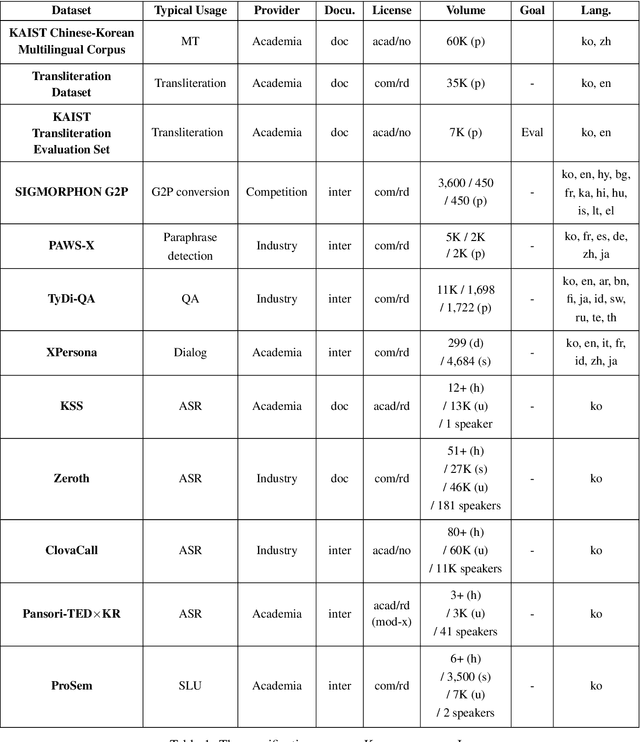Youngsook Song
KoGEC : Korean Grammatical Error Correction with Pre-trained Translation Models
Jun 13, 2025Abstract:This research introduces KoGEC, a Korean Grammatical Error Correction system using pre\--trained translation models. We fine-tuned NLLB (No Language Left Behind) models for Korean GEC, comparing their performance against large language models like GPT-4 and HCX-3. The study used two social media conversation datasets for training and testing. The NLLB models were fine-tuned using special language tokens to distinguish between original and corrected Korean sentences. Evaluation was done using BLEU scores and an "LLM as judge" method to classify error types. Results showed that the fine-tuned NLLB (KoGEC) models outperformed GPT-4o and HCX-3 in Korean GEC tasks. KoGEC demonstrated a more balanced error correction profile across various error types, whereas the larger LLMs tended to focus less on punctuation errors. We also developed a Chrome extension to make the KoGEC system accessible to users. Finally, we explored token vocabulary expansion to further improve the model but found it to decrease model performance. This research contributes to the field of NLP by providing an efficient, specialized Korean GEC system and a new evaluation method. It also highlights the potential of compact, task-specific models to compete with larger, general-purpose language models in specialized NLP tasks.
* 11 pages, 2 figures
Stop learning it all to mitigate visual hallucination, Focus on the hallucination target
Jun 13, 2025Abstract:Multimodal Large Language Models (MLLMs) frequently suffer from hallucination issues, generating information about objects that are not present in input images during vision-language tasks. These hallucinations particularly undermine model reliability in practical applications requiring accurate object identification. To address this challenge, we propose \mymethod,\ a preference learning approach that mitigates hallucinations by focusing on targeted areas where they occur. To implement this, we build a dataset containing hallucinated responses, correct responses, and target information (i.e., objects present in the images and the corresponding chunk positions in responses affected by hallucinations). By applying a preference learning method restricted to these specific targets, the model can filter out irrelevant signals and focus on correcting hallucinations. This allows the model to produce more factual responses by concentrating solely on relevant information. Experimental results demonstrate that \mymethod\ effectively reduces hallucinations across multiple vision hallucination tasks, improving the reliability and performance of MLLMs without diminishing overall performance.
* Accepted to CVPR 2025
Better Safe Than Sorry? Overreaction Problem of Vision Language Models in Visual Emergency Recognition
May 21, 2025Abstract:Vision-Language Models (VLMs) have demonstrated impressive capabilities in understanding visual content, but their reliability in safety-critical contexts remains under-explored. We introduce VERI (Visual Emergency Recognition Dataset), a carefully designed diagnostic benchmark of 200 images (100 contrastive pairs). Each emergency scene is matched with a visually similar but safe counterpart through multi-stage human verification and iterative refinement. Using a two-stage protocol - risk identification and emergency response - we evaluate 14 VLMs (2B-124B parameters) across medical emergencies, accidents, and natural disasters. Our analysis reveals a systematic overreaction problem: models excel at identifying real emergencies (70-100 percent success rate) but suffer from an alarming rate of false alarms, misidentifying 31-96 percent of safe situations as dangerous, with 10 scenarios failed by all models regardless of scale. This "better-safe-than-sorry" bias manifests primarily through contextual overinterpretation (88-93 percent of errors), challenging VLMs' reliability for safety applications. These findings highlight persistent limitations that are not resolved by increasing model scale, motivating targeted approaches for improving contextual safety assessment in visually misleading scenarios.
Open Korean Corpora: A Practical Report
Dec 31, 2020
Abstract:Korean is often referred to as a low-resource language in the research community. While this claim is partially true, it is also because the availability of resources is inadequately advertised and curated. This work curates and reviews a list of Korean corpora, first describing institution-level resource development, then further iterate through a list of current open datasets for different types of tasks. We then propose a direction on how open-source dataset construction and releases should be done for less-resourced languages to promote research.
 Add to Chrome
Add to Chrome Add to Firefox
Add to Firefox Add to Edge
Add to Edge